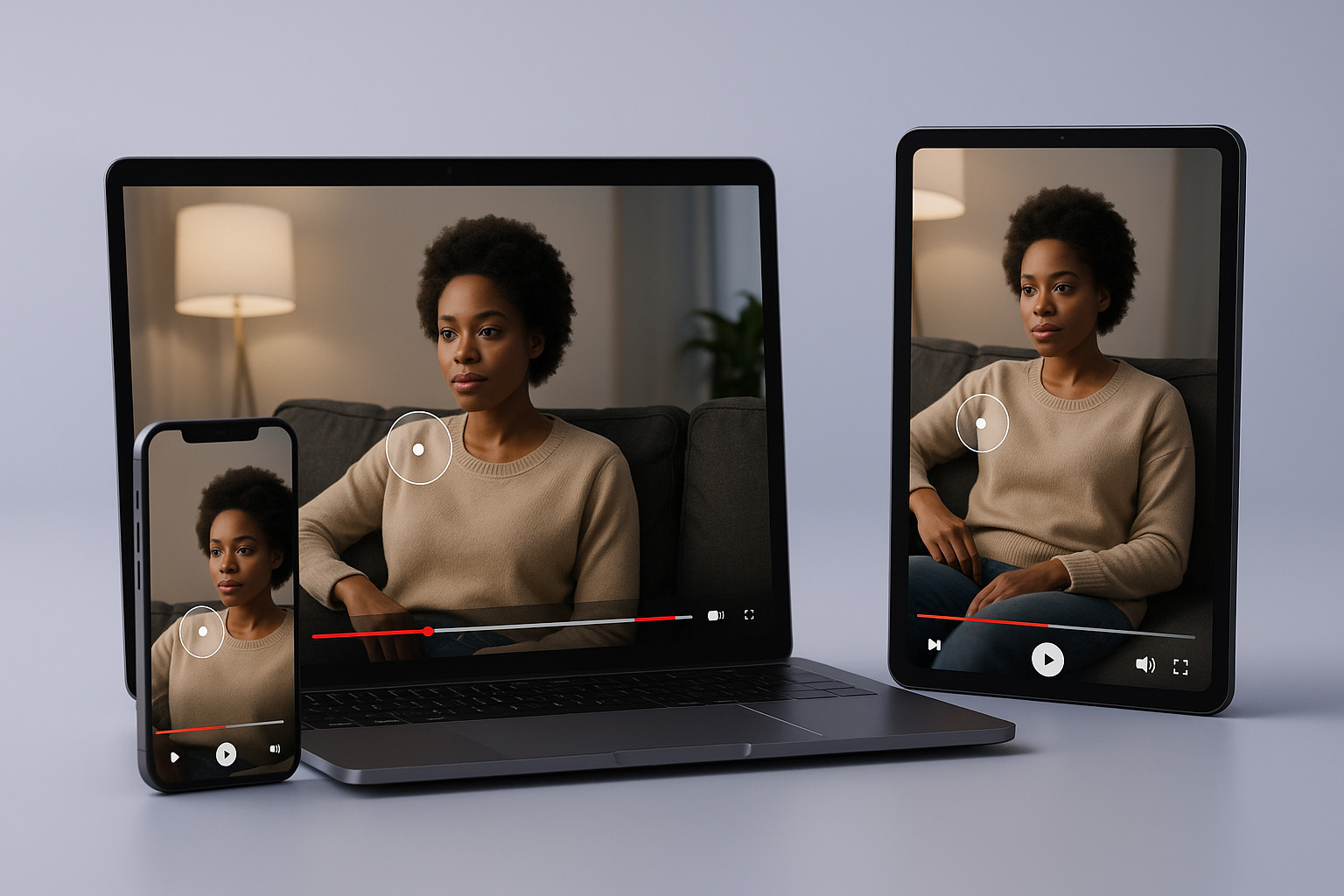Creating a strong eCommerce video SEO strategy is essential for boosting visibility and conversions. This guide outlines 10 critical steps to help you optimize your video content for SEO success and improve audience engagement.
Step 1: Plan Your Videos Around Relevant, Educational Content
Develop videos that educate your audience, such as product demos and how-to guides, providing value while improving SEO visibility through relevant, informative content.
Create Product Demo or Explainer Videos
Product demo and explainer videos are a great way to show your products and help potential buyers understand their features and benefits. By using product videos, you can demonstrate the product in real-time and show how it solves specific problems while highlighting its unique advantages.
- Highlight key products: Focus on best-sellers or new arrivals.
- Use clear visuals: Ensure explanations are easy to follow.
- Answer questions: Address common customer inquiries.
Implementing a short-video strategy can help you deliver this content effectively.
Focus on Providing Value with How-To Content
Educational videos like how-tos teach your audience something new. Whether you are demonstrating how to use your product or offering expert advice, videos like these build trust, position your brand as a knowledgeable resource.
- Instructional guides: Teach step-by-step processes.
- Tips and tricks: Share advice that helps users get more from your products.
- Problem-solving videos: Address common challenges your audience faces.
Step 2: Upload Your Videos to YouTube
Leverage YouTube’s massive user base and SEO advantages by uploading your videos, optimizing titles and descriptions, and adding backlinks to drive traffic.
Use YouTube’s SEO Advantages
By uploading your videos to YouTube, you tap into its large user base and improve your chances of showing up in search results, both on YouTube and Google. Be sure to optimize your video’s title, description, and tags with relevant keywords.
- Use primary keywords: Include them in the video title and description.
- Design engaging thumbnails: Create custom thumbnails to draw attention.
- Optimize metadata: Add relevant tags and descriptions to improve discoverability.
Include Backlinks to Your Website
Including backlinks in your video descriptions encourages viewers to explore your site further, increasing the likelihood of conversions. Include calls-to-action in your video descriptions, such as inviting viewers to request a demo, to encourage them to engage further with your brand.
- Add CTAs: Use calls-to-action to drive traffic to your website.
- Link to product pages: Include links in descriptions for seamless navigation.
- Boost SEO: Links from YouTube can enhance your site’s authority.
Step 3: Add Compelling Titles, Descriptions, and Tags
Incorporate relevant keywords in your titles, descriptions, and tags to enhance your video’s discoverability on YouTube and Google, improving search rankings.
Use Keywords in Your Video Title and Description
To improve your SEO potential, conduct keyword research and incorporate relevant search terms into your video’s title and description. Doing so helps your video rank higher in both YouTube and Google search results.
- Use relevant keywords: Include them naturally in titles and descriptions.
- Keep titles under 60 characters: Ensure they display fully in search results.
- Optimize descriptions: Provide detailed content summaries.
Add Tags for Improved Search Understanding
Tags play an important role in helping search engines understand the content of your videos. Add relevant tags that include variations of your primary keyword to improve your video’s visibility.
- Use topic-based tags: Reflect key themes of your video.
- Include keyword variations: Capture broader search queries.
- Enhance discoverability: Help search engines categorize your content.
Step 4: Embed Videos on Your Website
Embedding YouTube videos on your website boosts engagement, improves SEO, and keeps visitors on your pages longer, driving conversions.
Use YouTube Embed Codes
Embedding YouTube videos on your website can enhance user engagement while benefiting from YouTube’s hosting infrastructure. Integrating immersive video experiences on product pages or blog posts allows visitors to stay longer on your site, thereby improving SEO performance and driving engagement.
- Use YouTube embeds: Ensure fast loading times by embedding videos.
- Embed on relevant pages: Use product pages and blog posts for video placement.
- Optimize for mobile: Ensure videos are responsive for all devices. Implementing a vertical video strategy can enhance mobile user experience.
Pair Embedded Videos with Text-Based Content
To further optimize for SEO, combine your videos with text content like detailed descriptions or transcripts. Combining videos with text ensures that search engines can properly index the content, while also catering to visitors who prefer reading.
- Add descriptions: Include text summaries next to videos.
- Use transcripts: Provide full transcripts for better SEO.
- Enhance accessibility: Offer multiple formats to engage more users.
Step 5: Optimize for Total Watch Time (TWT)
Create longer, high-quality videos to increase total watch time, a key factor for YouTube and Google rankings, ensuring higher viewer engagement.
Create Longer Videos for Increased Engagement
Longer videos often result in higher total watch time, which is a key ranking factor for YouTube and Google. While short videos can be useful, producing longer, more in-depth content can boost engagement and improve your SEO. However, ensure the length is justified by the quality of content to keep viewers watching.
- Produce longer videos: Offer comprehensive content to keep viewers engaged.
- Increase watch time: Create videos that encourage longer viewing sessions.
- Provide valuable insights: Offer detailed information that holds attention.
Ensure Audience Retention in the First 15 Seconds
The first few seconds of a video are crucial for retaining viewers. Starting with a compelling hook that addresses a question or problem can keep viewers watching. Retaining your audience for longer periods signals to search engines that your content is valuable.
- Start with a hook: Capture attention right from the beginning.
- Address audience needs: Provide solutions to common problems.
- Improve retention: Keep viewers engaged early on.
Step 6: Use Audience Retention Tactics
Grab viewers’ attention within the first 15 seconds to reduce drop-off rates and keep them watching longer, boosting video retention.
Focus on Engaging Content in the First 15 Seconds
Capturing attention immediately is critical. By delivering an engaging statement or intriguing question within the first 15 seconds, you reduce drop-off rates and retain more viewers throughout your video.
- Intriguing hook: Start with an interesting fact or question.
- Engage quickly: Grab attention before viewers click away.
- Improve watch time: Hold attention to increase overall engagement.
Step 7: Boost Session Watch Time
Create playlists to guide viewers through related content, increasing session watch time and encouraging more engagement with your videos.
Create Playlists to Keep Viewers Engaged
Building themed playlists helps guide viewers through multiple videos, increasing overall session watch time. Playlists keep viewers on your channel longer and allow them to explore content that addresses their needs at different stages of the buying journey.
- Organize related videos: Group similar content into playlists.
- Guide viewers: Create playlists that align with the buyer’s journey.
- Increase watch time: Playlists encourage viewers to watch more content.
Add Links to Other Videos or Your Channel
Encouraging viewers to explore related videos extends their session on your channel. Use links in descriptions and video end screens to direct them to other relevant content.
- Add video links: Include links to related videos in the description.
- Use end screens: Suggest more content at the end of videos.
- Increase engagement: Keep viewers watching by guiding them to more videos.
Step 8: Build Links and Generate Social Shares
Promote your videos across social media and email marketing to encourage sharing, increase visibility, and drive more traffic to your content.
Encourage Social Sharing
Sharing your videos across social media platforms broadens your reach and enhances visibility. Utilizing live video commerce strategies can enhance customer engagement with video. Encourage your followers to engage with your content by liking, sharing, and commenting.
- Post on social platforms: Share videos across social media.
- Encourage engagement: Prompt viewers to like, comment, and share.
- Collaborate with influencers: Work with influencers to expand your reach.
Use Email Marketing for Video Promotion
Including video content in your email marketing strategy can drive traffic and increase viewership. Use video thumbnails with clear calls-to-action to encourage recipients to watch.
- Embed video thumbnails: Link to videos in your email campaigns.
- Segment audiences: Tailor video content to specific audience segments.
- Drive traffic: Use email to guide recipients to your video content.
Step 9: Optimize Thumbnails and Metadata
Design engaging thumbnails and include primary keywords in titles and descriptions to improve click-through rates and discoverability on search engines.
Design Engaging Thumbnails
Your video thumbnail is the first visual that potential viewers see. Creating a custom, eye-catching thumbnail increases the likelihood of clicks and can significantly impact viewership.
- Use high-quality images: Ensure thumbnails are clear and relevant.
- Add text overlays: Include a brief title or key phrase.
- Align with branding: Keep thumbnails consistent with your brand’s style.
Add Primary Keywords to Titles and Descriptions
Optimizing titles and descriptions with primary keywords improves search rankings and discoverability. Incorporate these terms naturally to help search engines understand your content.
- Use relevant keywords: Include keywords in titles and descriptions.
- Write clear titles: Keep them under 60 characters for better visibility.
- Optimize descriptions: Provide context and additional keywords.
Step 10: Continuously Analyze and Adjust Your Strategy
Use analytics to track video performance, refine your approach, and stay updated on industry trends to maintain your competitive edge.
Use Analytics to Track Video Performance
Tracking metrics like watch time, views, and engagement rates provides insights into your video performance. Regular analysis helps identify areas for improvement and keeps your strategy aligned with your business goals.
- Monitor key metrics: Track views, engagement, and watch time.
- Refine your strategy: Use data to optimize future videos.
- Adjust content: Make adjustments based on viewer feedback and performance.
Stay Updated on Industry Trends
The digital landscape evolves quickly, so it’s important to stay informed about emerging video marketing trends and updates to SEO algorithms. Continuously adjusting your strategy ensures that you maintain a competitive edge.
- Follow industry trends: Stay informed about video SEO updates.
- Adapt your content: Adjust based on new opportunities or technologies.
- Refine strategies: Keep your SEO tactics up-to-date for better performance.
Conclusion
By following these ten steps, you’ll be on your way to creating an eCommerce video SEO strategy that increases visibility, engages your audience, and drives conversions. Start implementing these strategies today to enhance your online presence and achieve your business goals.
Unlock Exclusive Insights
By submitting this form, you agree to Firework's privacy policy and consent to receive personalized marketing communications. You can unsubscribe at any time.





























